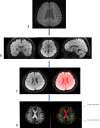Dynamic brain glymphatic changes and cognitive function in COVID-19 recovered patients: a DTI-ALPS prospective cohort study
- PMID: 40330302
- PMCID: PMC12053492
- DOI: 10.3389/fpsyg.2025.1465660
Dynamic brain glymphatic changes and cognitive function in COVID-19 recovered patients: a DTI-ALPS prospective cohort study
Abstract
Objective: This study aimed to evaluate brain glymphatic function in COVID-19 recovered patients using the non-invasive Diffusion Tensor Imaging-Analysis Along the Perivascular Space (DTI-ALPS) technique. The DTI-ALPS technique was employed to investigate changes in brain glymphatic function in these patients and explore correlations with cognitive function and fatigue.
Materials and methods: Follow-up assessments were conducted at 1, 3, and 12 months post-recovery. A total of 31 patients completed follow-ups at all three time points, with 30 healthy controls (HCs) for comparison.
Results: Compared to HCs, COVID-19 recovered patients showed a significant decline in MoCA scores at 3 months post-recovery (p < 0.05), which returned to near-normal levels by 12 months. Mental fatigue, measured by the Fatigue Assessment Scale (FAS), was significantly higher in COVID-19 patients at all follow-up points compared to HCs (p < 0.05). The DTI-ALPS index in both hemispheres showed significant differences at 3 months post-recovery compared to HCs (p < 0.001), indicating increased glymphatic activity. Longitudinal analysis revealed a peak in the DTI-ALPS index at 3 months post-recovery, which then decreased by 12 months. Correlation analysis showed a significant negative correlation between the Bilateral brain hemisphere DTI-ALPS index and MoCA scores (right side: r = -0.373, p = 0.003; left side: r = -0.255, p = 0.047), and a positive correlation with mental fatigue (right side: r = 0.275, p = 0.032; left side: r = 0.317, p = 0.013).
Conclusion: This study demonstrates dynamic changes in brain glymphatic function in COVID-19 recovered patients, with a peak in activity at 3 months post-recovery. These changes are associated with cognitive function and mental fatigue, suggesting potential targets for addressing neurological symptoms of long COVID. The non-invasive DTI-ALPS technique proves to be a valuable tool for assessing brain glymphatic function in this population.
Keywords: COVID-19 recovered patients; DTI-ALPS; brain glymphatic function; cognitive function; fatigue.
Copyright © 2025 He, Xie, Fang, Guo, Shi, Li, Liu, Zhu, Bao, Niu, Wang, Fu, Li and Xie.
Conflict of interest statement
SW was employed by company MR Research Collaboration, Siemens Healthineers. The remaining authors declare that the research was conducted in the absence of any commercial or financial relationships that could be construed as a potential conflict of interest.
Figures




Similar articles
-
Glymphatic system impairment in Alzheimer's disease: associations with perivascular space volume and cognitive function.Eur Radiol. 2024 Feb;34(2):1314-1323. doi: 10.1007/s00330-023-10122-3. Epub 2023 Aug 23. Eur Radiol. 2024. PMID: 37610441
-
Glymphatic function assessment with diffusion tensor imaging along the perivascular space in patients with major depressive disorder and its relation to cerebral white-matter alteration.Quant Imaging Med Surg. 2024 Sep 1;14(9):6397-6412. doi: 10.21037/qims-24-510. Epub 2024 Aug 19. Quant Imaging Med Surg. 2024. PMID: 39281139 Free PMC article.
-
Impaired glymphatic system in patent foramen ovale based on diffusion tensor imaging analysis along the perivascular space.Quant Imaging Med Surg. 2025 Apr 1;15(4):2987-2999. doi: 10.21037/qims-24-1963. Epub 2025 Mar 19. Quant Imaging Med Surg. 2025. PMID: 40235821 Free PMC article.
-
Diffusion Tensor Imaging Along the Perivascular Space Is a Promising Imaging Method in Parkinson's Disease: A Systematic Review and Meta-Analysis Study.CNS Neurosci Ther. 2025 May;31(5):e70434. doi: 10.1111/cns.70434. CNS Neurosci Ther. 2025. PMID: 40376934 Free PMC article. Review.
-
Diffusion Tensor Imaging Analysis Along the Perivascular Space (DTI-ALPS) in Normal Pressure Hydrocephalus: A Review of Recent Advances.Cureus. 2025 Apr 7;17(4):e81830. doi: 10.7759/cureus.81830. eCollection 2025 Apr. Cureus. 2025. PMID: 40337579 Free PMC article. Review.
References
-
- Alkodaymi M. S., Omrani O. A., Fawzy N. A., Shaar B. A., Almamlouk R., Riaz M., et al. . (2022). Prevalence of post-acute COVID-19 syndrome symptoms at different follow-up periods: a systematic review and meta-analysis. Clin. Microbiol. Infect. 28, 657–666. doi: 10.1016/j.cmi.2022.01.014, PMID: - DOI - PMC - PubMed
LinkOut - more resources
Full Text Sources
Research Materials
Miscellaneous

